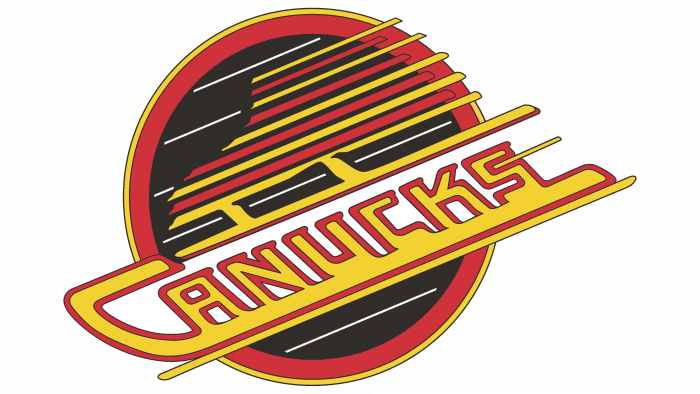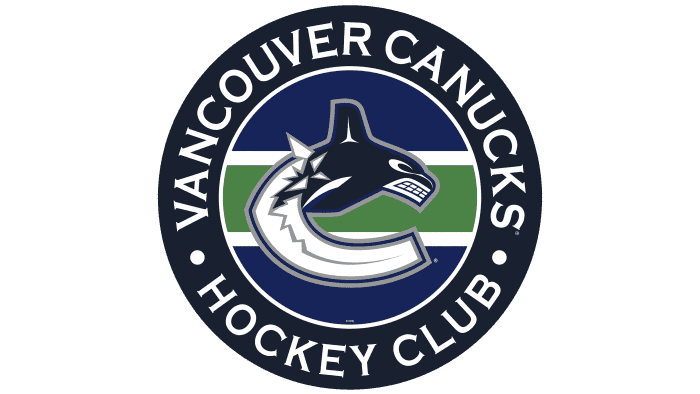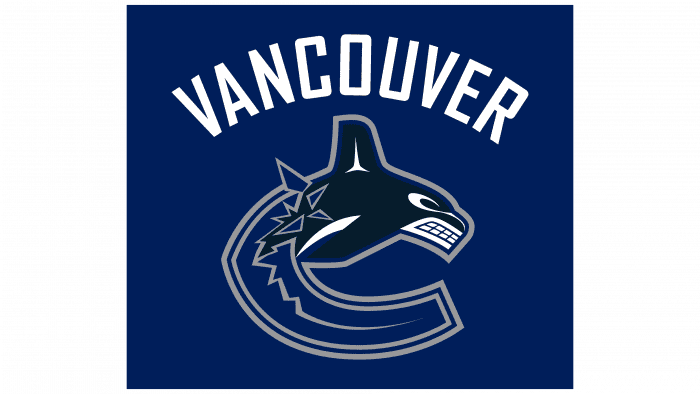The memorable original logo of the Vancouver Canucks focuses on the hockey club’s mascot and the first letter of its name. The animal symbolizes the ability to achieve goals, intellect, and respect, displaying the cunning and power of a predatory beast.
Vancouver Canucks: Brand overview
| Founded: | 1945 |
| Founder: | Canucks Sports & Entertainment |
| Headquarters: | Vancouver, British Columbia |
| Website: | nhl.com |
Meaning and History
The “Vancouver Canucks” have had five logos, some of which are similar in design and differ only in minor details. The hockey stick transformed into a killer whale emerging from the water in the early years. This indicates a complete rethinking of style during the redesign process.
What is Vancouver Canucks?
The “Vancouver Canucks” is one of the two oldest teams in the National Hockey League that has never won the Stanley Cup. It debuted in 1945 in the Pacific Coast Hockey League and moved to the NHL in 1970. The club is based in Canada and plays home games at Rogers Arena.
1970 – 1978
The first NHL team emblem is a blue horizontal rectangle with rounded corners. It’s framed in a muted green color. A white line, curved like a hockey stick, points towards the outer center. It divides the geometric figure and resembles the letter “C” – the first letter in the word Canucks. Known as Stink-in-Rink, this logo was created by graphic designer Joe Borovich from North Vancouver.
1978 – 1992
In 1978, the hockey club acquired an emblem unofficially called the “Flying V.” It’s related to its round shape and a large number of parallel diagonal stripes. The central element is divided into two semicircles with the inscription CANUCKS, styled like a skate blade. Stretched lines of uneven length create a sense of rapid movement. The palette also changed dramatically: the harmonious combination of blue and white was replaced by a contrasting mix of bright orange, gold, and black.
1992 – 1997
The Flying V became a symbol of success for the “Vancouver Canucks” in the first half of the 1990s when the hockey players won several decisive matches. However, this happened after the palette change: in 1992, gold turned into yellow-orange-red.
1997 – 2007
The logo adopted in 1997 features the club’s main mascot – a killer whale. It’s leaping out of the water, but instead of splashes, there are fragments. The entire graphic composition forms the letter “C,” which embodies the team’s name. The graphics are associated with the west coast of British Columbia and refer to Orca Bay Sports & Entertainment, which bought the franchise in 1995. The color scheme changed beyond recognition: the emblem includes dark blue, light blue, gray, white, and burgundy colors.
2007 – 2019
In 2007, the logo’s palette changed again: this time, there were no burgundy stripes around the orca’s contour, and the water acquired a more subdued shade of blue. But the updated colors were not the only novelty: designers added the inscription “VANCOUVER.” The word, denoting the club’s hometown, is placed at the top in an arch shape.
2019 – today
The emblem with the inscription was used only until the 2019-2020 season. Then, the developers removed the text to focus on the orca.
Vancouver Canucks: Interesting Facts
The Vancouver Canucks are an ice hockey team from Vancouver, Canada. They play in the NHL and have many fans who care about them.
- How They Started: They first played in 1945 in smaller leagues before joining the NHL in 1970 as a new team.
- Why “Canucks”?: “Canucks” is a friendly way to say Canadians. The team got its name to show off Canadian pride.
- Trying for the Cup: The Canucks have played in the Stanley Cup Finals three times (1982, 1994, and 2011) but haven’t won yet. Each time they got close, the whole area of Vancouver and beyond got super excited.
- Jersey Honors: They’ve retired a few players’ numbers, like Stan Smyl’s #12 and the Sedin twins’ #22 and #33, so no one else on the team will wear those numbers again. It’s their way of saying thanks for being awesome players.
- The Sedin Twins: Henrik and Daniel Sedin are famous twins who played their whole NHL career with the Canucks. They scored a lot of points and did a lot of good things in the community.
- Towel Power: In 1982, their coach waved a white towel to protest the referees’ calls. Fans loved it and started waving white towels at games to support the team.
- The “Green Men”: Two fans wear green suits and do funny things to distract the other team’s players. They became a fun part of going to Canucks games.
- Helping Out: The team helps kids and schools in British Columbia through the Canucks for Kids Fund, which is nice of them.
- Fin the Mascot: Their mascot is a killer whale, which matches their orca logo. Fin is a big hit at games and events.
- Big Rivalries: Games against the Calgary Flames and Chicago Blackhawks are extra exciting because of their big rivalry, which means these teams have a history of intense matches.
The Vancouver Canucks mean a lot to Vancouver, not just for hockey but for bringing people together and helping out in the community.
Font and Colors
Featuring an animal mascot in logos is a common practice among teams in professional sports, and the Vancouver Canucks are no exception. Its emblem depicts a killer whale leaping out of the water. The composition resembles the letter “C”. This is a nod to the emblem from 1970-1978, where the main element was a hockey rink with a stick resembling the letter “C.”
There are no inscriptions in the modern logo – they were only included in older versions of the club’s emblem. For example, from 1978 to 1997, the drawing was supplemented with the word “CANUCKS”, written diagonally in a unique font. All the letters at the bottom were connected by a long line, resembling a skate blade. The second time the inscription appeared in 2007-2019: “VANCOUVER” in sans serif with many rounded corners.
The current color palette is presented in two shades – blue, gray, and white. In 1997-2007, burgundy complemented it, and the blue was brighter. From 1987 to 1997, two emblems were used, with a palette dominated by yellow and orange colors. The classic combination is considered to be blue and green, as in the emblem from 1970-1978.
Vancouver Canucks color codes
| Green | Hex color: | #008852 |
|---|---|---|
| RGB: | 0 136 82 | |
| CMYK: | 96 2 100 12 | |
| Pantone: | PMS 348 C |
| Blue | Hex color: | #00205b |
|---|---|---|
| RGB: | 0 32 91 | |
| CMYK: | 100 85 5 36 | |
| Pantone: | PMS 281 C |
| Dark Blue | Hex color: | #041c2c |
|---|---|---|
| RGB: | 4 28 44 | |
| CMYK: | 100 73 28 86 | |
| Pantone: | PMS 296 C |
| Cool Gray | Hex color: | #97999b |
|---|---|---|
| RGB: | 151 153 155 | |
| CMYK: | 20 14 12 40 | |
| Pantone: | PMS Cool Gray 7 C |
FAQ
Who designed the Canuck logo?
The first version of the logo, with an image of a killer whale bursting out of the letter C, was designed by artist Brent Lynch. This happened in 1997. Joe Borovich created the famous emblem introduced in 1970.
Why do the “Canucks” have an emblem with a whale?
The killer whale depicted on the “Vancouver Canucks” emblem is the team’s mascot. It was chosen from many other candidates for this role, outperforming the beaver, a robot goalie, a lumberjack, a camel, and other characters that never became mascots of the hockey club.
What does the “Vancouver Canucks” logo represent?
The team’s logo combines the main elements of its identity: the orca and the first letter of the word “Canucks”. The cetacean predator bursts out of the top half of the letter “C.” This is how the artists depicted the orca leaping out of the water. The color scheme is simple: two shades of blue, white, and gray.
Do the “Canucks” change their logo?
In recent years, the “Vancouver Canucks” logo has changed, but not drastically. For example, in 2019, designers fine-tuned details and updated the colors, making the orca slightly lighter.












